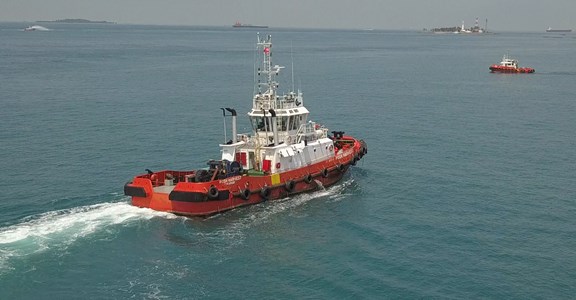
Towards Unmanned Waters
Imagine vessels navigating autonomously, with their routes plotted and controlled by computers located on shore, and ship management systems making rational decisions and issuing situational commands to control the vessel. This is the future of shipping.

Autonomy is the future that many companies, including ST Engineering, are sailing towards. We collaborated with ship owner, PACC Offshore Services Holdings (POSH), classification society, American Bureau of Shipping (ABS), and port authority, Maritime Authority of Singapore (MPA), to convert a manned tugboat into a Smart Autonomous Maritime Vessel (SMAV) for safer, more sustainable and more efficient shipping of tomorrow.
The scope of development and conversion work included the retrofitting of sensors into the existing equipment and fittings on board to allow the control and monitoring using our in-house NERVA Ship Management and Sensemaking System (NERVA SMS2), a remote centralised control and health monitoring system. This results in better predictive diagnostics and prognostics on critical shipboard systems, enabling crew to focus on higher value tasks. Through the use of data analytics, machine learning and AI, these forward-looking maintenance capabilities allow for lifespan extension of onboard systems and equipment, and reduce expenditure for vessel owners as the NERVA system minimises unnecessary replacements or functional failures.

NERVA Ship Management System, for centralised control and monitoring of platform sensors and systems
Besides NERVA SMS2, we also integrated our autonomous waypoint navigation with collision Detection and Collision Avoidance to help improve operational efficiencies and safety through the use of autonomous systems and algorithms.
“The maritime industry is increasingly disrupted by autonomous technologies and we continue to partner like-minded industry partners to develop smart autonomous solutions. Combined with our deep engineering expertise and innovative approach, we hope to accelerate the development of unmanned technologies for safer and greener seas,” said Ng Tee Guan, Vice President, Marine Technology & Solutions, Marine, ST Engineering.
However, it is not a journey without challenges. Similar to autonomous vehicles, key challenges include the lack of existing standards, regulations, liabilities and social acceptance. Without such baselines to guide us through the project, we set forth to define the project goals and formulate the project requirements with valuable input from our project partners. We worked with ABS to review the existing COLREGS (International Regulations for Preventing Collisions at Sea) and made relevant recommendations for changes related to liability, evasive manoeuvres, visibility and identification of autonomous vessels. These recommendations were accepted by MPA and will be part of their contributions to the International Maritime Organisation (IMO).

Sea trials on navigation autonomy
Despite these challenges, the team completed the sea trials for SMAV within 15 months from project commencement. A first-of-its-kind trials in Singapore waters, the SMAV trial involved various scenarios such as head-on, crossing from left, crossing from right and overtaking, and in varying speeds up to 8 knots while the vessel was in autonomous waypoint navigation mode. The team also successfully completed an official demonstration to MPA in October 2020, showcasing the SMAV’s capabilities in autonomous waypoint navigation from shore. We continue to collaborate with MPA to explore and develop autonomous maritime operations and capabilities in Singapore.
Development work continues, as we conduct further trials to validate the robustness of the collision avoidance algorithm, as well as test the effectiveness and accuracy of the NERVA SMS2.
This is only the beginning of our journey towards autonomous vessels, the future of shipping.
Sales and Enquiries
Subscribe to our newsletter
Copyright © 2025 ST Engineering
By subscribing to the mailing list, you confirm that you have read and agree with the Terms of Use and Personal Data Policy.

